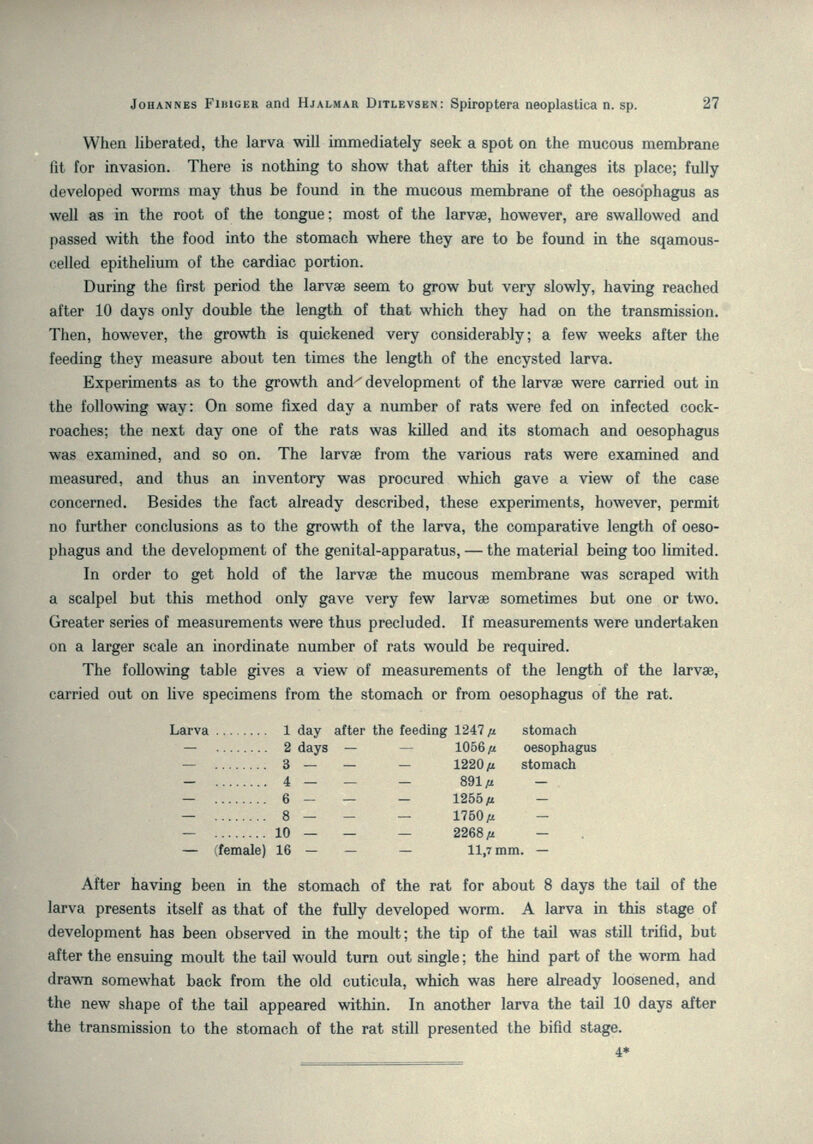
Full resolution (JPEG) - On this page / på denna sida - Contributions to the Biology and Morphology of Spiroptera (Gongylonema) Neoplastica n. sp.

<< prev. page << föreg. sida << >> nästa sida >> next page >>
Below is the raw OCR text
from the above scanned image.
Do you see an error? Proofread the page now!
Här nedan syns maskintolkade texten från faksimilbilden ovan.
Ser du något fel? Korrekturläs sidan nu!
This page has never been proofread. / Denna sida har aldrig korrekturlästs.
When liberated, the larva will immediately seek a spot on the mucous membrane
fit for invasion. There is nothing to show that after this it changes its place; fully
developed worms may thus be found in the mucous membrane of the oesdphagus as
well as in the root of the tongue ; most of the larvæ, however, are swallowed and
passed with the food into the stomach where they are to be found in the sqamous-
celled epithelium of the cardiac portion.
During the first period the larvæ seem to grow but very slowly, having reached
after 10 days only double the length of that which they had on the transmission.
Then, however, the growth is quickened very considerably ; a few weeks after the
feeding they measure about ten times the length of the encysted larva.
Experiments as to the growth and^’development of the larvæ were carried out in
the following way: On some fixed day a number of rats were fed on infected cock-
roaches; the next day one of the rats was killed and its stomach and oesophagus
was examined, and so on. The larvæ from the various rats were examined and
measured, and thus an inventory was procured which gave a view of the case
concerned. Besides the faet already described, these experiments, however, permit
no further conclusions as to the growth of the larva, the comparative length of oeso-
phagus and the development of the genital-app aratus, — the material being too limited.
In order to get hold of the larvæ the mucous membrane was scraped with
a scalpel but this method only gave very few larvæ sometimes but one or two.
Greater series of measurements were thus precluded. If measurements were undertaken
on a larger scale an inordinate number of rats would be required.
The following table gives a view of measurements of the length of the larvæ,
carried out on live specimens from the stomach or from oesophagus of the rat.
Larva 1 day after the feeding 1247 /t stomach
— 2 days — — 1056 fx oesophagus
— 3— — — 122Q[i stomach
— 4 — — - 891// —
— 6- — - 12bb[i -
— 8— - — 1750 /* -
— 10 — — — 2268 /t -
— (female) 16 — — — 11,7 mm. —
After having been in the stomach of the rat for about 8 days the tail of the
larva presents itself as that of the fully developed worm. A larva in this stage of
development has been observed in the moult; the tip of the tail was still trifid, but
after the ensuing moult the tail would turn out single ; the hind part of the worm had
drawn somewhat back from the old cuticula, which was here already loosened, and
the new shape of the tail appeared within. In another larva the tail 10 days after
the transmission to the stomach of the rat still presented the bifid stage.
<< prev. page << föreg. sida << >> nästa sida >> next page >>